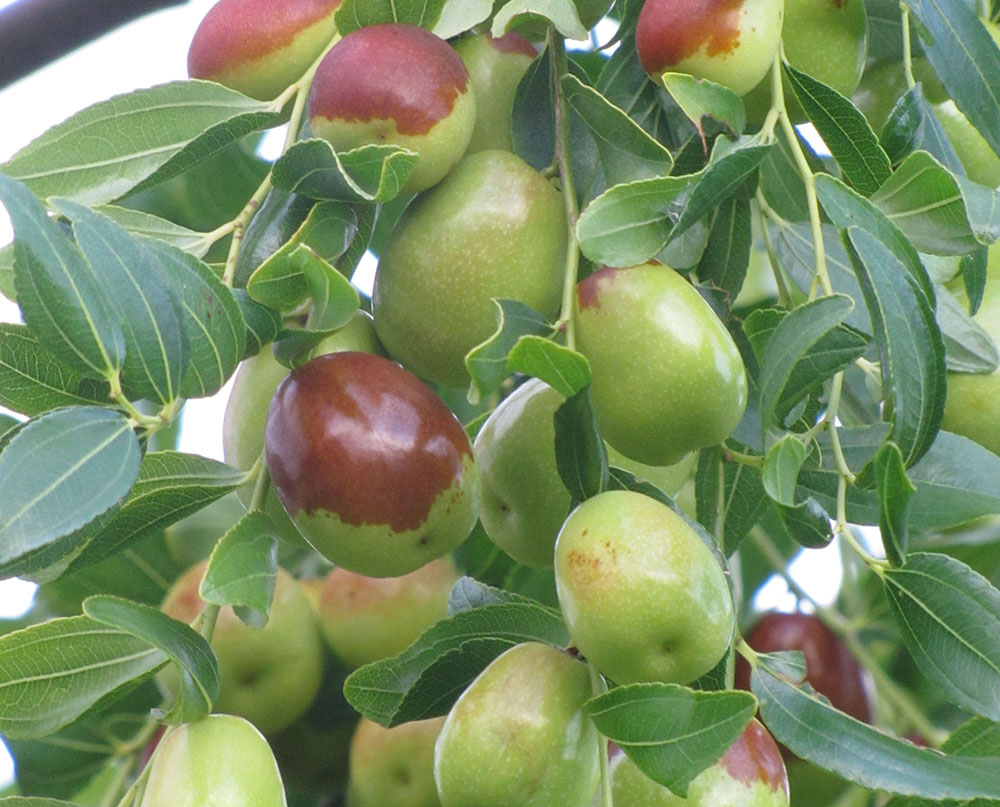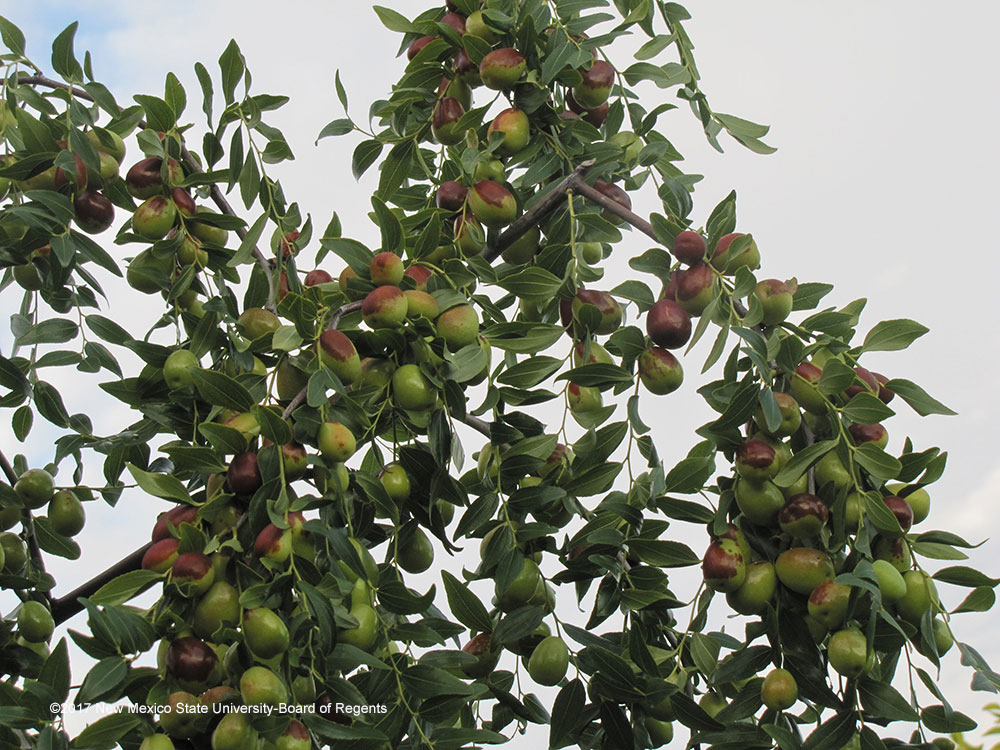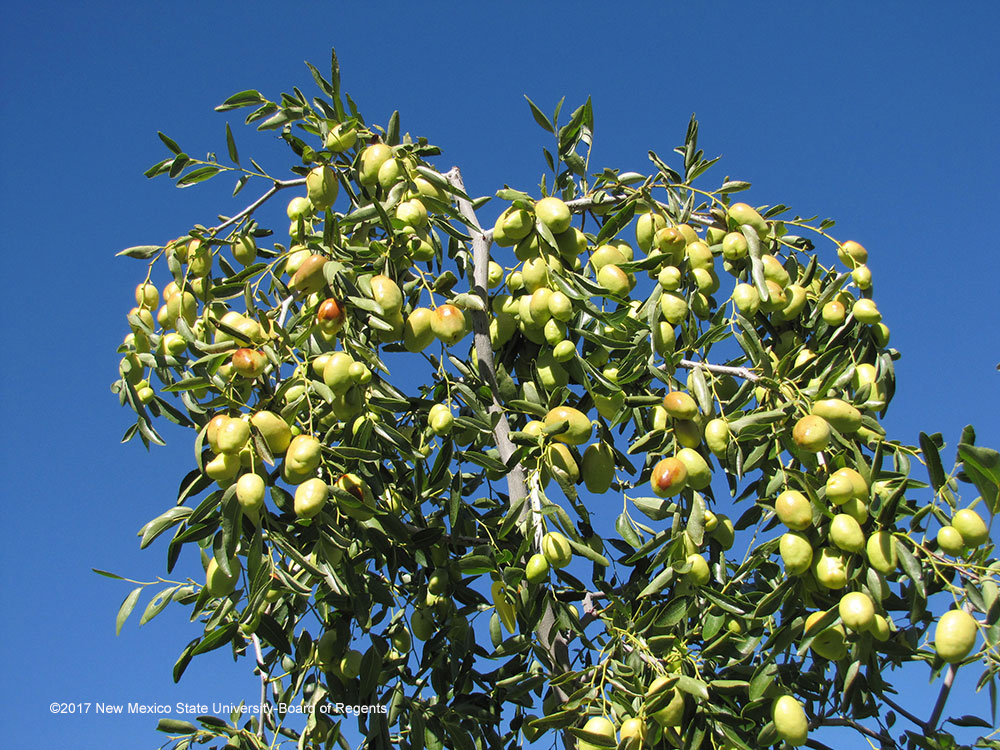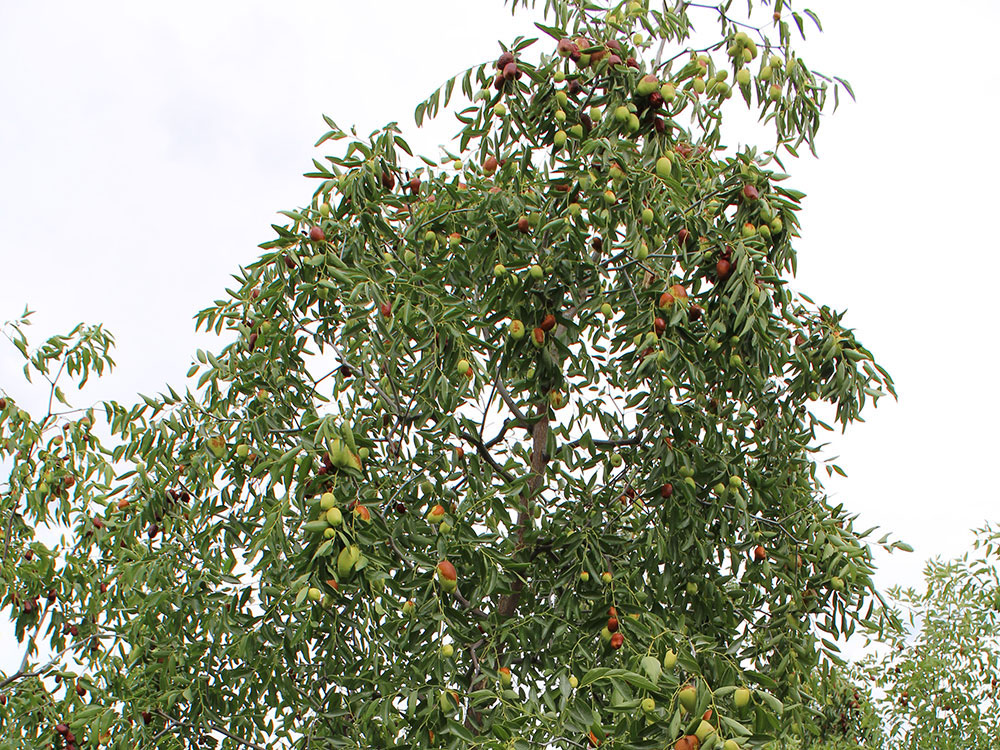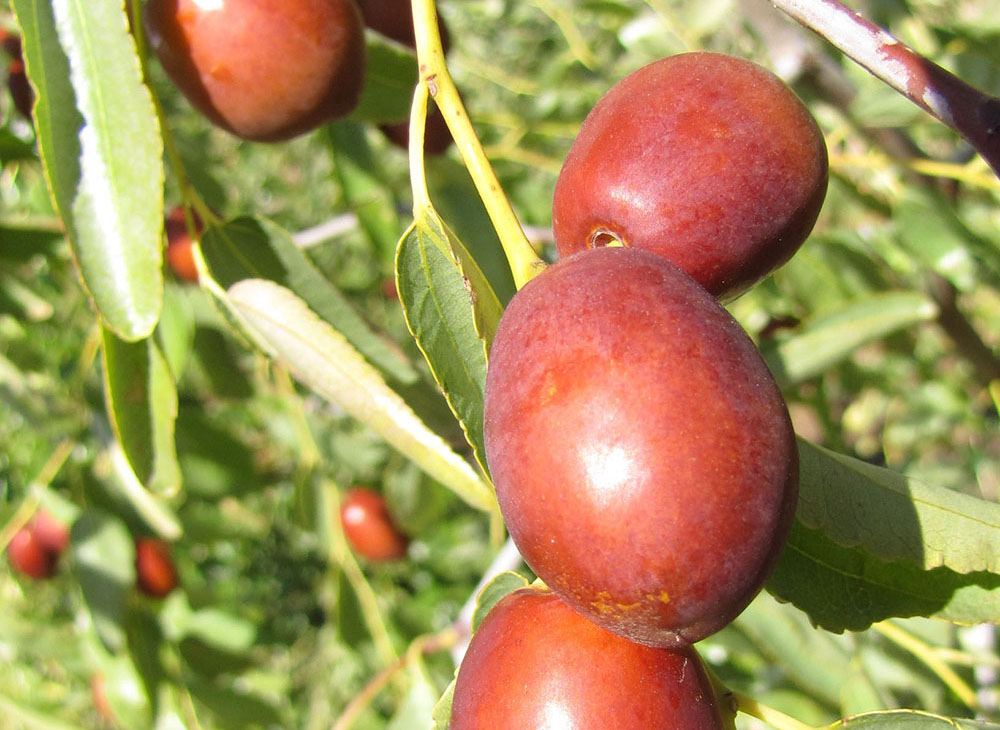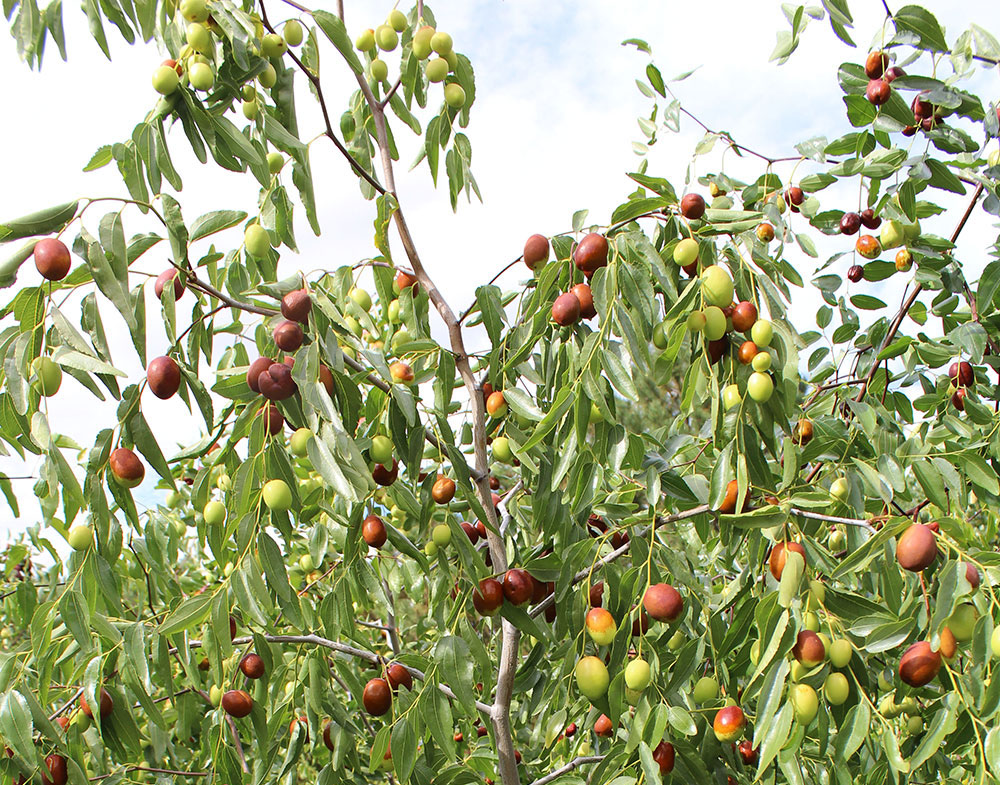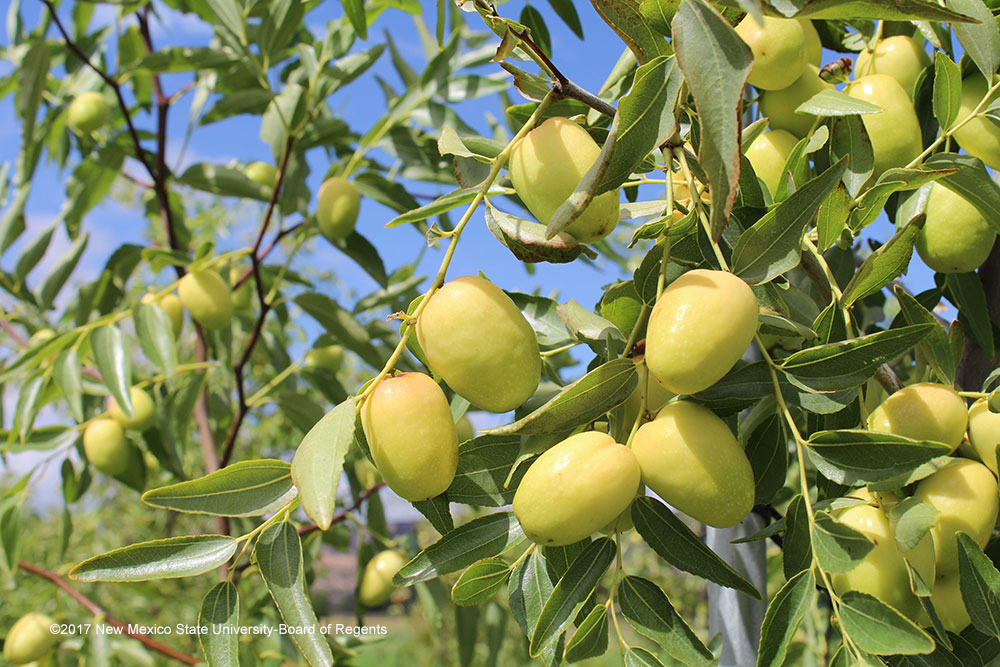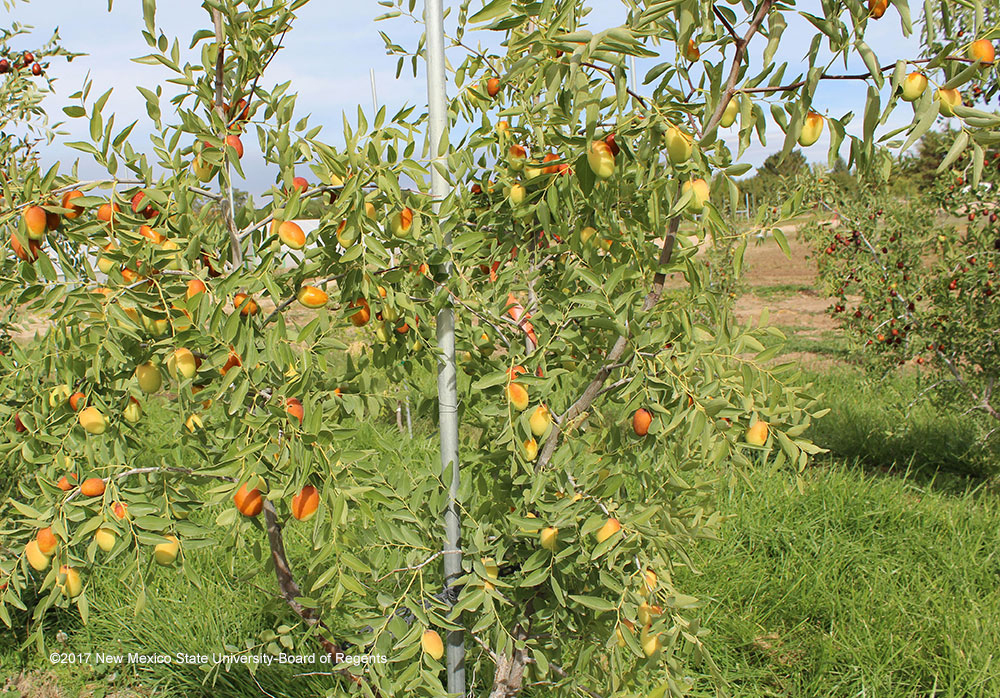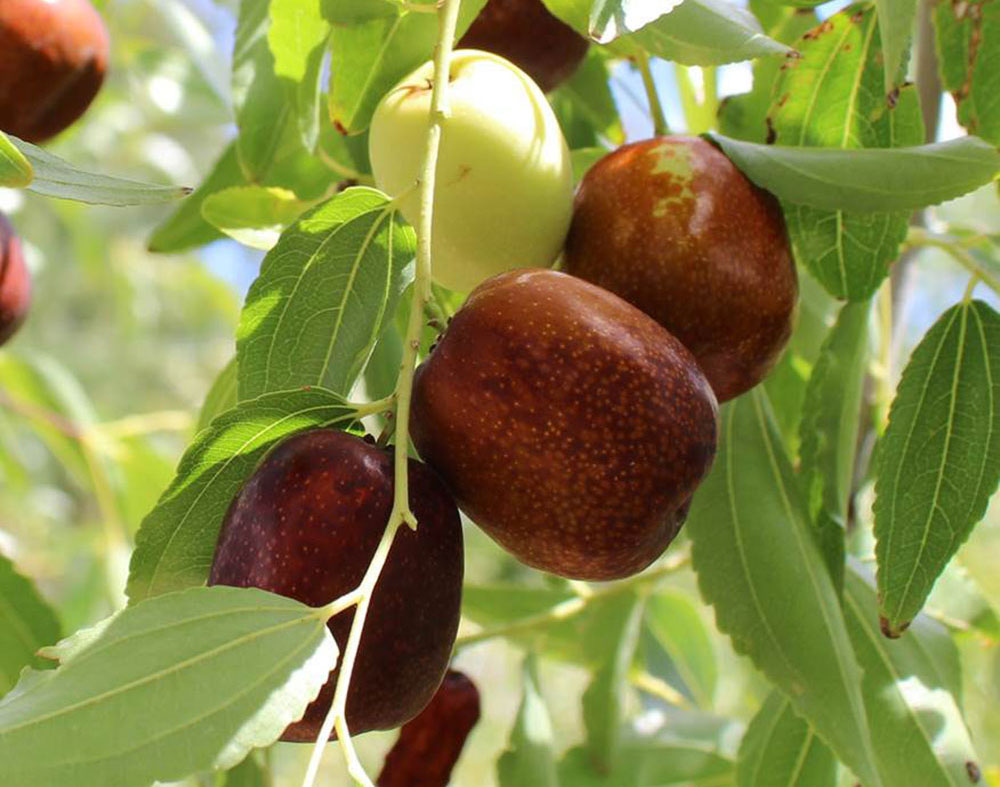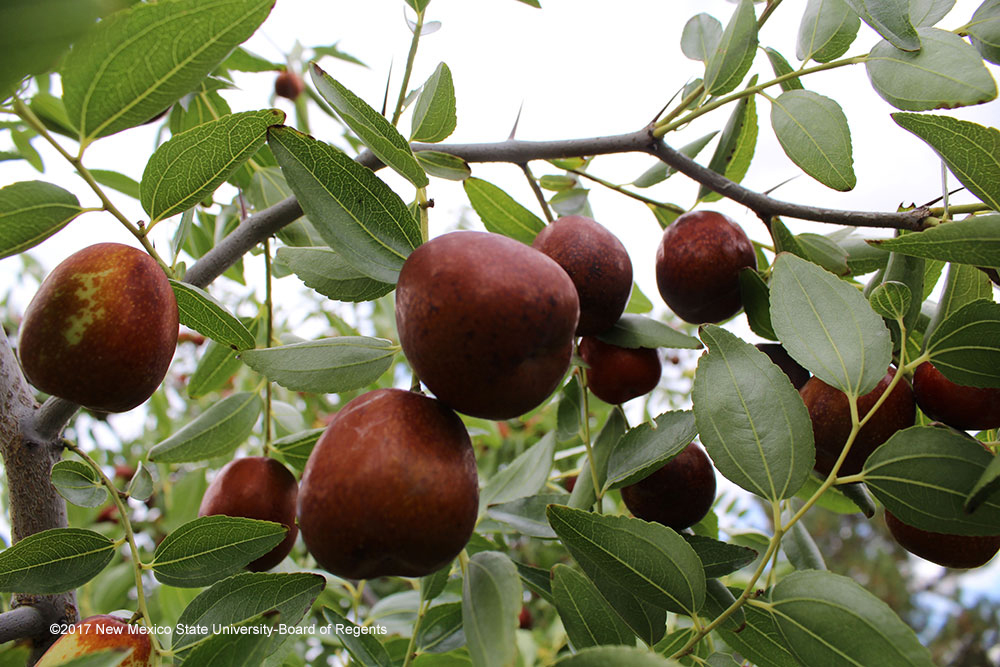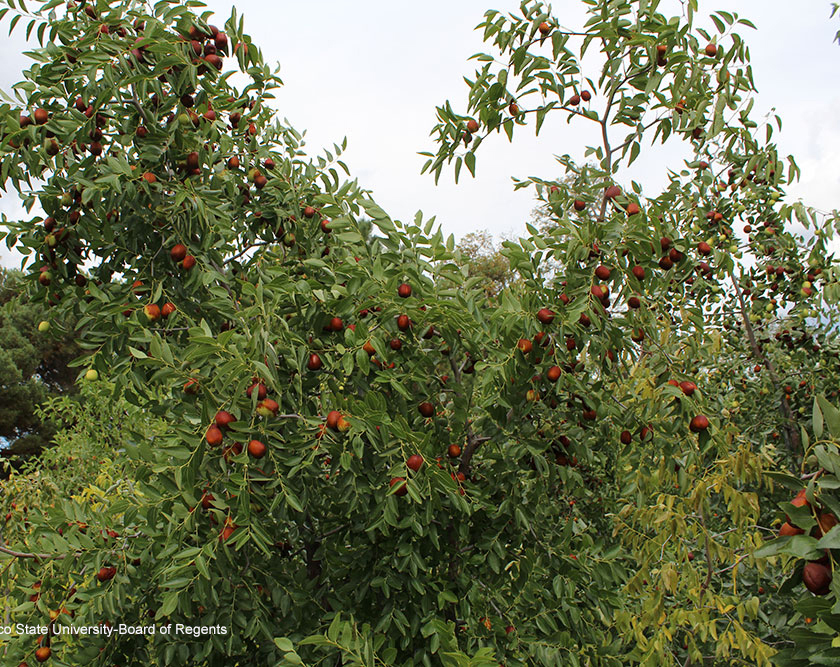For Multipurpose Use
Click thumbnail images below to see full sized-image.
Abbeville
©2024 New Mexico State University- Board of Regents
Abbeville:Found in Abbeville, LA, origin unknown. New Mexico had similar cultivar planted in 1910 at Gila with identical SNP markers. A productive late cultivar with small fruit. Best fruit set among all cultivars tested at Alcalde, NM. Mediocre for fresh eating and drying. Fruit hanging well on the trees after maturation.
AmeriZao™ Chaoyang
©2024 New Mexico State University- Board of Regents
Chaoyang: (朝阳大平顶, Chaoyangdapingding, Chaoyang flattop, AMERIZAO™ Chaoyang):Imported into the US in 2011 by New Mexico State University. Originally from Chaoyang area, Liaoning province, China. Small to medium in size, 5.6g in northern NM and 7.5g in central NM, 31.5-33.0_Brix, column shaped, light brown/red color, uniform fruit, slightly tart flavor. Early to mid-season in maturation. Fresh eating or drying. Suitable for marginal regions with short growing season.
Jin
©2024 New Mexico State University- Board of Regents
Jin:Origin not sure. Could be imported from China. A productive cultivar at Alcalde. Non-uniform medium sized fruit. Good for both fresh eating and drying. Not included in the cultivar trials. Limited information.
AmeriZao™ JKW (Jinkuiwang)
©2024 New Mexico State University- Board of Regents
Jinkuiwang: (‘金魁王’; AMERIZAO™ Jinkuiwang, AMERIZAO™ JKW): Drying or multipurpose, for commercial production. Origin: Cangzhou Jinsixiaozao Nursery, Cangzhou, Hebei Province, China; released 2001; imported to U.S. 2011 by New Mexico State University. Fruit: 14-15 g; ovoid; skin russets in New Mexico; flesh thick; 35-40_Brix for full red fruit in south and central New Mexico; ripens mid-late season; good for fresh use, excellent for drying. Tree: vigor high; canopy full, larger than ‘Jinsi 2’ and ‘Jinsi 3’; precocious and productive.
AmeriZao™ Jinsi-2
©2024 New Mexico State University- Board of Regents
Jinsi 2: (‘金丝二号’; AMERIZAO™ Jinsi 2):Drying or multipurpose, adapted to marginal regions with short growing seasons. Origin: Shandong Institute of Pomology, Shandong Province, China. ‘Jinsixiaozao’ selection; released 1998; imported to U.S. 2011 by New Mexico State University. Fruit: midsize, 6.8-8.4 g; ovoid; texture firm; 35-42.0_Brix for full red fruit in New Mexico; ripens early to midseason; good for fresh use; drying quality excellent, with typical ‘Jinsixiaozao’ sweet-tart flavor. Tree: vigor medium to weak; midsize; canopy full.
AmeriZao™ Jinsi-3
©2024 New Mexico State University- Board of Regents
Jinsi 3: (‘金丝三号’; AMERIZAO™ Jinsi 3): Drying or multipurpose cultivar for commercial production. Origin: Shandong Institute of Pomology, Shandong Province, China. Selection from Weihai area, Shandong Province; released 1998; imported to U.S. 2011 by New Mexico State University. Fruit: midsize, 12.5-13.3g; ovoid; texture firm; 35-40.7 _Brix for full red fruit in New Mexico; ripens mid- to late-season; very good for fresh use, excellent for drying, with typical ‘Jinsixiaozao’ sweet-tart flavor. Tree: vigor medium to high, with full canopy, larger than ‘Jinsi 2’.
AmeriZao™ Jinsi-4
©2024 New Mexico State University- Board of Regents
Jinsi 4 (金丝四号, AMERIZAO™ Jinsi 4):Drying or multipurpose, adapted to marginal regions with short growing seasons. Origin: a seedling from open-pollinated Jinsi #2 Origin: Shandong Institute of Pomology, Shandong Province, China. imported to U.S. 2011 by New Mexico State University. Fruit: small size, 6.9-7.5 g; slim long column shape; texture firm; 29.5-35.5 _Brix for full red fruit in New Mexico; ripens early to midseason; good for fresh use; drying quality excellent, with typical ‘Jinsixiaozao’ sweet-tart flavor. Tree: weak; small sized. It was reported the early setting fruit were larger in China. DNA genotyping with SNP markers revealed that Jinsi 4 was not grouped together with Jinsi #2, Jinsi #3 and JKW.
AmeriZao™ KFC (Kongfucui)
©2024 New Mexico State University- Board of Regents
Kongfucui: (‘孔府脆’; ‘KFC’; AMERIZAO™ Kongfucui, AMERIZAO™ KFC): Fresh use or multipurpose jujube for commercial production. Origin: Shandong Institute of Pomology, Shandong Province, China. Selection from existing trees, parentage unknown; released 2000; imported to U.S. 2011 by New Mexico State University. Fruit: midsize, 11.5-14.0 g; oblong; skin shiny, bumpy; flavor excellent, 26-32 _Brix for full red fruit in New Mexico; ripens mid- to mid-late season; very good for fresh use, good for drying. Tree: branches limited, but existing fruit spurs keep producing heavy crops; reliably productive across New Mexico.
AmeriZao™ Miyun
©2024 New Mexico State University- Board of Regents
Miyunxiaozao: (AMERIZAO™ Miyun)Origin: Miyun County, Beijing, China. Imported into the US in 2011 by New Mexico State University. One of the AMERIZAOTM Jinsi series cultivars. Medium to small in size. Very sweet. Excellent for fresh eating and drying. Not included in the cultivar trial. Limited information. DNA genotyping indicated Miyunxiaozao with identical sequences with other Jinsi series cultivar.
Mu
©2024 New Mexico State University- Board of Regents
Mu: Could be Mu Shing Hong imported by Frank Meyer in 1908 with PI 22684. Origin: China. Introduced 1924. The current Mu had medium-sized fruit, not uniform. Tree: large, young shoots had long nodes with curved side branches.
AmeriZao™ Pitless
©2024 New Mexico State University- Board of Regents
Pitless: (‘无核小枣’, ‘Wuhexiaozao’, ‘Wuhezao’; AMERIZAO™ Pitless):Small-fruited, very sweet, virtually seedless. Origin: traditionally grown in northern Shandong and eastern Hebei Provinces, China, near Bohai Bay; imported to U.S. by New Mexico State University 2011. ‘Jinsi’ mutation with incomplete kernel and exposed seeds inside. Fruit: small, 4-6 g; ovoid; skin bright red; 35-40 _Brix in New Mexico; ripens early to midseason; dried fruit quality excellent, similar to ‘Jinsi’ series; suitable as an amendment of tea or as a component of eight treasure tea. Tree: medium to large, canopy full; productive across New Mexico; for home gardeners or special use in commercial production, and suitable for marginal regions with short growing seasons.
Sept Late
©2024 New Mexico State University- Board of Regents
Sept late: (九月青): Imported into the US by Roger Meyer in 1990s. Late cultivar, yellowish brown/red color. A productive late cultivar. Light in fruit color when mature. Fine fruit texture. Cannot fully mature in northern New Mexico. Not included in the cultivar trial, may have good potential in southern NM. High pollen germinating rate and good pollinizer tree. Good for fresh eating and drying.
Sherwood
©2024 New Mexico State University- Board of Regents
Sherwood:Late-ripening, for fresh use and drying, for home gardens and commercial growers. Origin: Sibley, LA, by J.S. Akin. Parentage unknown; sent to Louisiana from China. Fruit: midsize, 17-18.2 g; elongated/cylindrical, uniform; 29-33 _Brix for full-red fruit in central and southern New Mexico; ripens late; for fresh use and drying. Tree: growth habit upright in young trees, weeping in mature trees; yield heavy; suitable for home gardens and commercial production; suitable for 2012 USDA Zone 7a and higher.
Shuimen
©2024 New Mexico State University- Board of Regents
Shuimen:Elongated fruit, for fresh use and drying. Origin: imported to U.S. 1914 from Paihsiangchen, Shanxi Province, China by F.N. Meyer as PI 38245; introduced 1924. Fruit: midsize; elongated, tapered at stigma end; ripens early to midseason; for fresh use and drying; lower in vitamin C content (_200mg/100g FW) than other cultivars. Tree: growth habit moderately upright; yield medium to high; suitable for marginal regions with short growing seasons.
Sihong
©2024 New Mexico State University- Board of Regents
Sihong: (‘泗洪大枣’):High-quality multipurpose jujube. Origin: Sihong County, Jiangsu Province, China; imported by R. Meyer through Nanjing Botanical Garden; released 1995. Fruit: medium to large, 14.8-17.9 g; ovoid; skin attractive brown/red, slightly bumpy; texture firm; very sweet, 34-36.8 _Brix; fresh eating quality excellent; drying quality excellent, with fine wrinkles and thick flesh. Tree: vigor high, with plenty of branches; side branches straight, easy to stimulate primary shoots at ends of side branches; bears more on current-year shoots than older branches; yield moderate; for drying or multipurpose, suitable for home gardens and commercial production.
Sugarcane
©2024 New Mexico State University- Board of Regents
Sugar Cane: (‘Sugarcane’; ‘Yalta #1’, Coco™):Midsize, ovoid, very sweet and crunchy. Origin: Nikita Botanical Garden, Ukraine; imported by J. Gilbert in 1990s, and named CocoTM; renamed ‘Sugar Cane’ by R. Meyer. Based on recent DNA genotyping results with SNP markers, ‘Sugarcane’ and Coco™ refer to the same cultivar. Fruit: midsize, 9-11.5 g; ovoid; skin reddish-brown; flesh sweet, crunchy; 25-30 _Brix in New Mexico; ripens early-midseason; fresh eating quality and drying quality very good. Tree: growth habit spreading; canopy dense, with plenty of primary branches; spiny; yield medium to high; suitable for marginal regions with short growing seasons.
Topeka
©2024 New Mexico State University- Board of Regents
Topeka:origin: A cultivar originated in Kansas State. Very late fresh eating cultivar. Too late for northern New Mexico. Not included in our cultivar trial. Limited information. Our genotyping results with SNP markers indicated that Topeka had identical sequences as Sherwood. See Sherwood.
Yu
Yu:Origin: China. Imported into the US in 1913 by Frank N. Meyer with PI 36854. Not introduced in 1924. The Yu (1913) described in 1996 as: Fruit: large, elongated, tapering toward stylar end, skin reddish-brown, flesh sweet, firm, Keeping quality rather good. Tree: tall; main branches with few side branches; leaves large. The current Yu from late Roger Meyer may or may not be the same as the 1913 Yu. The current Yu was a special germplasm with lots of tiny flowers. We never noticed it bloomed or set fruit for 14 years at Alcalde, NM.
AmeriZao™ Zhongning
©2024 New Mexico State University- Board of Regents
Zhongningyuanzao: (中宁圆枣, AMERIZAO™ Zhongningyuanzao). Origin: Ningxia Province, China. Imported into the US by New Mexico State University in 2011. Medium sized, uniform short column-shaped fruit. Dark skin color. Sweet / tart balanced flavor. Early- to mid-season cultivar. Good for fresh eating and drying. Not included in the replicated cultivar trial, limited information.


